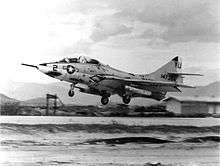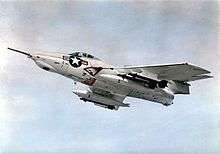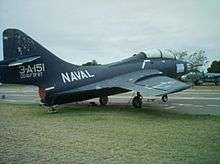Grumman F-9 Cougar
| F9F/F-9 Cougar | |
|---|---|
| | |
| Grumman F9F-6 Cougar, 1952 | |
| Role | Fighter aircraft |
| National origin | United States |
| Manufacturer | Grumman |
| First flight | 20 September 1951 |
| Introduction | 1952 (F9F-6) 1953 (F9F-8) |
| Retired | 1974, US Navy |
| Status | Retired |
| Primary users | United States Navy United States Marine Corps Argentine Navy |
| Number built | 1,392 |
| Developed from | Grumman F9F Panther |
The Grumman F9F/F-9 Cougar was an aircraft carrier-based fighter aircraft for the United States Navy. Based on Grumman's earlier F9F Panther, the Cougar replaced the Panther's straight wing with a more modern swept wing. Thrust was also increased significantly. The Navy considered the Cougar an updated version of the Panther, despite having a different official name, and thus Cougars started off from F9F-6 upward.
Design and development
Prototypes were quickly produced by modifying Panthers, and the first (XF9F-6) flew on 20 September 1951. The aircraft was still subsonic, but the critical Mach number was increased from 0.79 to 0.86 at sea level and to 0.895 at 35,000 ft (10,000 m), improving performance markedly over the Panther. The Cougar was too late for Korean War service, however, and thus combat effectiveness estimates of the Cougar against potential foes such as the (likewise subsonic, but not carrier-rated) Soviet Mikoyan-Gurevich MiG-15 necessarily remain in the sphere of conjecture.


Initial production (646 airframes) was the F9F-6, delivered from mid-1952 through July 1954. Armament was four 20 mm (.79 in) M2 cannons in the nose and provision for two 1,000 lb (450 kg) bombs or 150 US gal (570 l) drop tanks under the wings. Most were fitted with a UHF homing antenna under the nose, and some were fitted with probes for inflight refuelling. Later redesignated F-9F in 1962. Sixty were built as F9F-6P reconnaissance aircraft with cameras instead of the nose cannon.
F9F/F-9 Cougar is one of few aircraft which do not have ailerons; it uses spoilers for roll control.
After withdrawal from active service, many F9F-6s were used as unmanned drones for combat training, designated F9F-6K, or as drone directors, designated F9F-6D. The F9F-6K and the F9F-6D were redesignated the QF-9F and DF-9F, respectively.
F9F-7 referred to the next batch of Cougars that were given the Allison J33 engine instead of the Pratt & Whitney J48, a licensed-built Rolls-Royce Tay. A total of 168 were built, but the J33 proved both less powerful and less reliable than the J48. Almost all were converted to take J48s, and were thus indistinguishable from F9F-6s. These were redesignated F-9H in 1962.
The F9F-8 was the definitive fighter version.[1] It featured an 8 in (20 cm) stretch in the fuselage and modified wings with greater chord and wing area (from 300 to 337 square feet), to improve low-speed, high angle of attack flying and to give more room for fuel tanks.[1] As a result of the wing changes, top speed was increased from 687 to 704 mph and minimum catapult speed was lowered to 127 knots (146 mph). It also was now capable of breaking the sound barrier in a steep dive. All four ammunition boxes were mounted above the guns, in contrast to the split location of most previous F9Fs including the Panther.[2][1][3] 601 aircraft were delivered between April 1954 and March 1957; most were given inflight refuelling probes, and late production were given the ability to carry four AIM-9 Sidewinder air-to-air missiles under the wings. Most earlier aircraft were modified to this configuration. A number were given nuclear bombing equipment. These were redesignated F-9J in 1962.
The F9F-8B aircraft were F9F-8s converted into single-seat attack-fighters, later redesignated AF-9J.
A total of 110 F9F-8Ps were produced with an extensively modified nose carrying cameras. They were withdrawn after 1960 to reserve squadrons. In 1962, surviving F9F-6P and F9F-8P aircraft were re-designated RF-9F and RF-9J respectively.
Modifications of F9F-8 to convert to F9F-8P:
- The modification to eliminate the guns and related equipment and incorporate the photographic equipment and automatic pilot and their controls and instruments has resulted in the following changes:
- Rearrangement of electronics equipment installed in the area enclosed by the fuselage nose section, lengthening of this section by 12 inches, and shortening of the sliding nose section.
- Rearrangement of the left and right consoles and the main instrument panel to provide space for the controls associated with the additional equipment.
- Some minor changes of the fuselage structure and equipment installations to provide for the necessary ducting control for hot air from the engine compressor, which is used for defrosting the camera windows and heating the camera compartment.
- Removal of all armament and the Armament Control System, removal of AN/APG-30 system and installation of an additional armor plate bulkhead.[4]
The Navy acquired 377 two-seat F9F-8T trainers between 1956 and 1960. They were used for advanced training, weapons training and carrier training, and served until 1974. They were armed with twin 20 mm (.79 in) cannon and could carry a full bombs or missiles load. In the 1962 redesignation, these were called TF-9J.[5]
Operational history
United States
The F-9 arrived too late to see combat in the Korean war. It replaced the F9F Panther as the standard U.S. Navy carrier fighter in 1954.[6]
The only version of the Cougar to see combat was the TF-9J trainer (until 1962, F9F-8T). Detachments of four Cougars served with US Marines Headquarters and Maintenance Squadrons H&MS-11 at Da Nang and H&MS-13 at Chu Lai, where they were used for fast-Forward Air Control and the airborne command role, directing airstrikes against enemy positions in South Vietnam during 1966 and 1968.[7][8]
F9F-8s were withdrawn from front-line service in 1958–59, replaced by F11F Tigers and F8U Crusaders. The Naval Reserves used them until the mid-1960s, but none of the single-seat versions were used in the Vietnam War.
The TF-9J had a long service with the U.S. Navy, but the proposed Cougar modification (reengined with a J52 engine) was rejected, and the Navy selected the TA-4F Skyhawk. The last Cougar was phased out when VT-4 re-equipped on February 1974. A F9F-8T, BuNo 14276, is displayed at the National Museum of Naval Aviation, Pensacola.
Argentina

The only foreign air arm to use the F9F Cougar was the Argentine Naval Aviation, who used the F9F Panther as well. Two F9F-8T trainers were acquired in 1962, and served until 1971. The Cougar was the first jet to break the sound barrier in Argentina.[9] One aircraft (serial 3-A-151) is on display at the Naval Aviation Museum (MUAN) at Bahía Blanca, while the other was sold to an owner in United States.[10]
Variants




- XF9F-6
- First three prototypes of the F9F Cougar
- F9F-6
- 646 built; redesignated F-9F in 1962.
- F9F-6P
- 60 were built for reconnaissance
- F9F-6D
- drone directors, converted from F9F-6s; redesignated DF-9F in 1962.
- F9F-6K
- unmanned drones for combat training, converted from F9F-6s; redesignated QF-9F in 1962.
- F9F-6PD
- drone directors, converted from F9F-6Ps; redesignated DF-9F in 1962.
- F9F-6K2
- an improved version of the F9F-6K target drone, converted from F9F-6s; redesignated QF-9G in 1962.
- F9F-7
- 168 were built with the Allison J33 engine; most were converted to take J48s; redesignated F-9H in 1962.
- F9F-8
- 601 aircraft; redesignated F-9J in 1962; they had up to 4 AIM-9 Sidewinder missiles
- YF9F-8B
- Prototype for a single-seat attack-fighter aircraft converted from a F9F-8; later redesignated YAF-9J.
- F9F-8B
- F9F-8s converted into single-seat attack-fighters; later redesignated AF-9J.
- F9F-8P
- 110 photo-reconnaissance versions.
- YF9F-8T
- one F9F-8 aircraft converted into a prototype for the F9F-8T training aircraft; later redesignated YTF-9J.
- F9F-8T
- 377 two-seat trainers acquired; redesignated TF-9J in 1962.
- NTF-9J
- Two TF-9Js used for special test duties.
- YF9F-9
- Original designation of the YF11F-1 Tiger prototypes. First flight was on 30 July 1954; redesignated in April 1955.
Operators
Aircraft on display


Argentina
- F9F-8T
- 0516/3-A-151 (Argentine Navy) - Argentine Naval Aviation Museum (Museo de la Aviacion Naval - MUAN) at Bahía Blanca, Argentina.[10]
United States
- F9F-6
- 126670 - in storage at the National Air and Space Museum, Paul E. Garber Preservation, Restoration, and Storage Facility, Suitland, Maryland.[11]
- 128109 - National Naval Aviation Museum at NAS Pensacola, Florida.[12]
- F9F-6P
- unknown - The Town of Tonawanda Veterans Memorial in the Town of Tonawanda, New York.[13] The aircraft has been on display since 1959 and in 2009 was refurbished when the new Town of Tonawanda Veterans Memorial was created.[13]
- 127484 - Former Marine Corps aircraft has been a ground display for children to play on in Boysen Park in Anaheim, California, since about 1960. For safety reasons, in 1967 the aircraft was coated in gunite to cover sharp edges that had developed.[14][15]
- F9F-7
- 130763 - Cradle of Aviation Museum in Garden City, New York.[16]
- 130802 - Wings of Eagles Discovery Center in Horseheads, New York.[17]
- F9F-8
- 131063 - Texas Air Museum in Slaton, Texas.[18]
- 131230 - National Naval Aviation Museum at NAS Pensacola, Florida.[19]
- 131232 - Museum of Flight in Seattle, Washington.[20]
- 138876 - Pueblo Weisbrod Aircraft Museum in Pueblo, Colorado.[21]
- 141117 - Intrepid Sea-Air-Space Museum in New York, New York. It is on loan from the National Museum of Naval Aviation). It was built in Grumman's Bethpage factory in 1955 and retired from active service in 1965. Once restored, it will wear the colors of fighter squadron VF-61, which flew from Intrepid in 1956.[22]
- 141121 - Pima Air & Space Museum, adjacent to Davis-Monthan AFB, in Tucson, Arizona.[23]
- 144275 - Evergreen Aviation & Space Museum in McMinnville, Oregon. It is on loan from the National Museum of Naval Aviation and is painted to represent the narrator's aircraft for the U.S. Navy Blue Angels precision flight demonstration team.[24]
- F9F-8P
- 141675 - Yanks Air Museum in Chino, California.[25][26]
- 141702 - USS Midway Museum in San Diego, California.[27]
- 141722 - Flying Leatherneck Aviation Museum, MCAS Miramar in San Diego, California.[28]
- 144388 - Estrella Warbird Museum in Paso Robles, California.[29]
- 144426 - Pima Air & Space Museum, adjacent to Davis-Monthan AFB in Tucson, Arizona.[30]
- 144402 - Military Aviation Preservation Society, M.A.P.S. in Canton, Ohio.[31]
- F9F-8T
- 142442 - The Town of Woodridge, New York.[32]
- 147276 - USS Lexington Museum in Corpus Christi, Texas.[33]
- 147283 - Air Zoo in Kalamazoo, Michigan.[34]
- 147385 - USS Yorktown (CV-10) at the Patriot's Point Naval and Maritime Museum in Mount Pleasant, South Carolina.[35]
- 147397 - Pima Air & Space Museum, adjacent to Davis-Monthan AFB in Tucson, Arizona.[36]
Specifications (F9F-8/F-9J)
Data from The American Fighter[37] Grumman F9F Panther/Cougar[3]
General characteristics
- Crew: 1
- Length: 42 ft 1½ in (12.85 m)
- Wingspan: 34 ft 6 in (10.51 m)
- Height: 12 ft 3 in (3.73 m)
- Wing area: 337 ft² (31.3 m²)
- Empty weight: 11,866 lb (5,382 kg)
- Loaded weight: 20,098 lb (9,116 kg)
- Max. takeoff weight: 24,763 lb (11,232 kg)
- Powerplant: 1 × Pratt & Whitney J48-P-8A turbojet, 7,250 lbf (38 kN) with water injection
Performance
- Maximum speed: 714 mph (620.4 knots, 1,149 km/h)
- Cruise speed: 516 mph (448 knots, 830.4 km/h)
- Range: 1,050 mi (913 nmi, 1,690 km) without additional tanks
- Service ceiling: 42,000 ft (12,800 m)
- Rate of climb: 5,750 ft/min (29.2 m/s)
Armament
- Guns: 4 × 20 mm (0.79 in) M3 cannon, 190 rounds per gun
- Rockets: 6 × 5 in (127 mm) rockets
- Missiles: 4× AIM-9 Sidewinder air-to-air missiles
- Bombs: 2 × 1,000 lb (454 kg) bombs
See also
- Related development
- Aircraft of comparable role, configuration and era
- Related lists
References
Notes
- 1 2 3 Elward 2010, p. 128.
- ↑ Elward 2010, p. 114.
- 1 2 Elward 2010, p. 129.
- ↑ USN Flight Handbook, F9F-8
- ↑ Swanborough and Bowers 1990, pp. 249–251.
- ↑ "Grumman F9F Cougar Carrier-Borne Fighter Aircraft". www.militaryfactory.com. militaryfactory.com. Retrieved 18 September 2015.
- ↑ Mersky Aviation News 17–31 August 1989, pp. 320–322.
- ↑ Baugher, Joe. "Grumman F9F-8T/TF-9J Cougar." US Navy Fighters, 29 January 2000. Retrieved: 19 July 2011.
- ↑ "TR=AT Cougar". (Spanish) www.histarmar.com.ar. Retrieved: 19 July 2011.
- ↑ "F9F Cougar/126670" Smithsonian, National Air Museum. Retrieved: 12 January 2015.
- ↑ "F9F Cougar/128109." National Naval Aviation Museum. Retrieved: 15 January 2015.
- 1 2 Adamczyk, Ed. "Honoring those who served, and everyone else." Tonawanda News, 14 August 2009.
- ↑ "F9F Cougar/127484." aerialvisuals.ca Retrieved: 29 May 2015.
- ↑ [Issue] Contributors: Suzi Brown, Mike Ebbing, Nikki Moreno, Jane Newell, Meghan Schinderle, Karen Vera, Phil Yuhas (Winter 2006). Nicoletti, John James; Fontes, Linda, eds. "A Jet Fueled by Imagination" (PDF). Features. Anaheim Magazine (Anaheim, California: City of Anaheim): 14–15. Retrieved 19 June 2015.
- ↑ "F9F Cougar/130763." Cradle of Aviation Museum. Retrieved: 15 January 2015.
- ↑ "F9F Cougar/130802." aerialvisuals.ca Retrieved: 8 April 2015.
- ↑ "F9F Cougar/131063." Texas Air Museum. Retrieved: 30 October 2012.
- ↑ "F9F Cougar/131230." National Naval Aviation Museum. Retrieved: 15 January 2015.
- ↑ "F9F Cougar/131232." Museum of Flight. Retrieved: 30 October 2012.
- ↑ "F9F Cougar/138876" Pueblo Weisbrod Aircraft Museum. Retrieved: 21 January 2015.
- ↑ "F9F Cougar/141117." Intrepid Sea-Air-Space Museum Retrieved: 15 January 2015.
- ↑ "F9F Cougar/141121." Pima Air & Space Museum. Retrieved: 15 January 2015.
- ↑ "F9F Cougar/147275." Evergreen Aviation & Space Museum. Retrieved: 30 October 2012.
- ↑ "F9F Cougar/141675" Yanks Air Museum. Retrieved: 21 January 2015.
- ↑ "FAA Registry: N9256." faa.gov Retrieved: 21 January 2015/
- ↑ "F9F Cougar/141702." Midway Aircraft Museum. Retrieved: 30 October 2012.
- ↑ "F9F Cougar/141722." Flying Letherneck Aviation Museum. Retrieved: 15 January 2015.
- ↑ "F9F Cougar/144388." Estrella Warbird Museum. Retrieved: 21 January 2015.
- ↑ "F9F Cougar/144426." Pima Air & Space Museum. Retrieved: 15 January 2015.
- ↑ "F9F Cougar/144404." MAPS. Retrieved: 12 January 2014.
- ↑ "F9F Cougar/142442." The Town of Woodridge NY. Retrieved: 21 April 2014.
- ↑ "F9F Cougar/147276." USS Lexington Museum. Retrieved: 30 October 2012.
- ↑ "F9F Cougar/147283." Air Zoo. Retrieved: 15 January 2015.
- ↑ "F9F Cougar/147385." Patriot's Point Naval & Maritime Museum. Retrieved: 30 October 2012.
- ↑ "F9F Cougar/147397." Pima Air & Space Museum. Retrieved: 15 January 2015.
- ↑ Angelucci and Bowers 1987, p. 246.
Bibliography
- Angelucci, Enzo and Peter Bowers. The American Fighter. Sparkford, UK: Haynes, 1987. ISBN 0-85429-635-2.
- Mersky, Peter. "Flying Cougars and other unusual aircraft in Vietnam". Aviation News magazine, Vol. 18, No. 7, 17–31 August 1989. pp. 320–322.
- Neubeck, Ken. F9F Cougar Walk Around. Carrollton, Texas: Squadron/Signal Publications, 2012. ISBN 978-0-89747-666-9.
- Swanborough, Gordon and Peter M. Bowers. United States Navy Aircraft since 1911. Annapolis, Maryland: Naval Institute Press, 1990. ISBN 0-87021-792-5.
- Elward, Brad. Grumman F9F Panther/Cougar. North Branch, Minnesota: Specialty Press, 2010. ISBN 978-1-58007-145-1.
Online sources
- Cicalesi, Juan Carlos; Rivas, Santiago (22 December 2008). "Grumman Panther en Argentina" [Grumman Panther in Argentina]. Instituto Aeronaval - Articulos - Historia (in Spanish). Instituto Aeronaval. Retrieved 2014-08-28.
Further reading
| Wikimedia Commons has media related to Grumman F9F Cougar. |
- Núñez Padin, Jorge Felix (2010). Núñez Padin, Jorge Felix, ed. Grumman F9F Panther & Cougar. Serie Aeronaval (in Spanish) 29. Bahía Blanca, Argentina: Fuerzas Aeronavales. ISBN 978-987-1682-03-4. Retrieved 2014-08-26.
| ||||||||||||||||||||||||||||||||||||||||
| ||||||||||